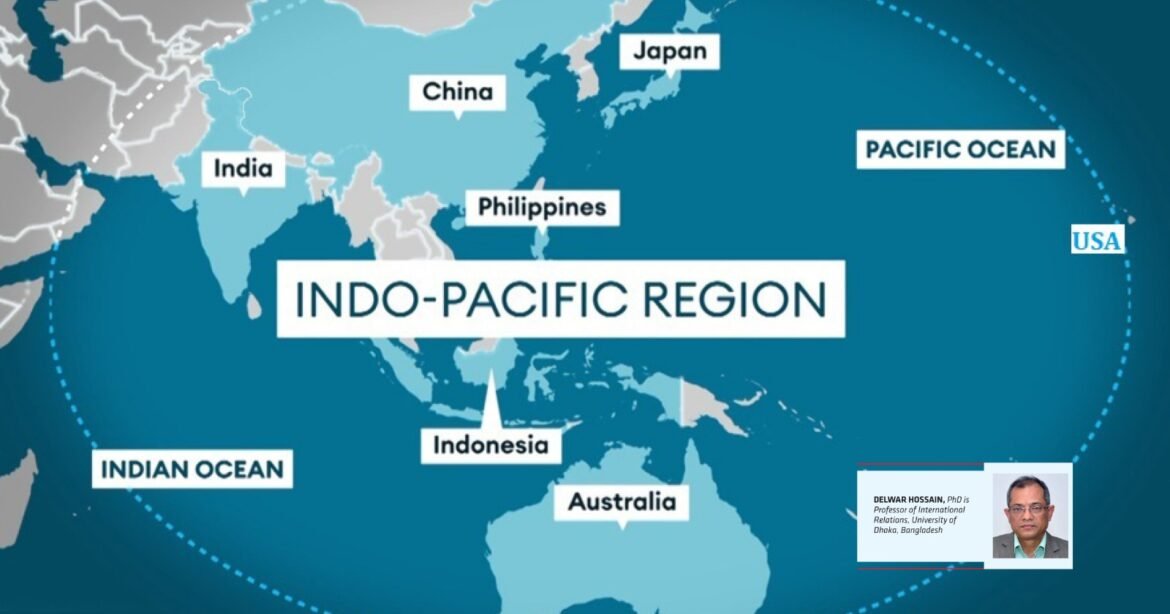The Indo-Pacific Region symbolizes a new arena of great power competition and rivalry. It has become a new theater of global politics. It has effectively reduced the importance of Europe or the Middle East as the epicenters of international relations. The emerging powers such as China, India, a G-7 member, Japan and a host of middle powers like South Korea, Indonesia, Australia, Malaysia, Thailand, and Bangladesh have carved a new space for development and diplomacy.
The status quo great powers such as the USA, Germany, France, UK and Italy are extensively linked with these Asian powers on economic, diplomatic, strategic and environmental terms. Hotspots such as the Ukraine War, the Taiwan Strait crisis and the Korean Peninsula crisis have signaled a new level of engagements of the great powers in the region. The idea of Indo-Pacific region is gradually becoming a zone of competition, rivalries and hostility. Newspapers headlines capture the developments in this vast region on a daily basis.
The idea of the Indo-Pacific region has its origin which is not very long rather it suddenly came into a discussion to depict a vast region, to signify a new notion of solidarity and cooperation among some great powers who have a common threat perception against emerging actors like China. At the same time, it came in the context when strategically world’s political landscape was in a benign position.
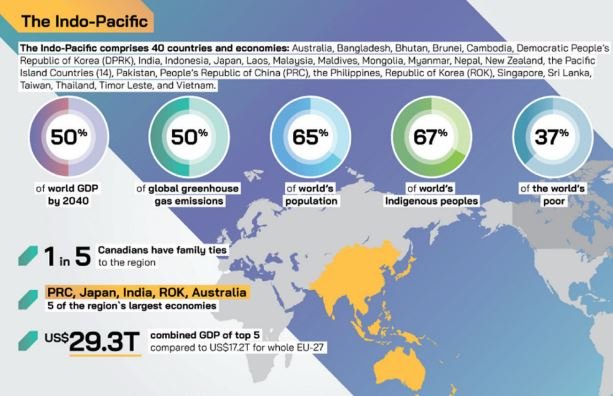
However, gradually it turned into a strategic compulsion for the USA and its allies to create a kind of strong community to promote its interests and to deal with emerging threats to the status quo or existing world order. As a result, the Indo-Pacific, which includes China, has developed into a great power political arena. In recognition of the integration of the Indian and Pacific Oceans as a single geostrategic theater and the growing importance of the maritime domain, the United States, Japan, India, Australia, and Indonesia, among others, have promoted the growing use of the “Indo-Pacific” terminology to replace the more familiar “Asia-Pacific.”
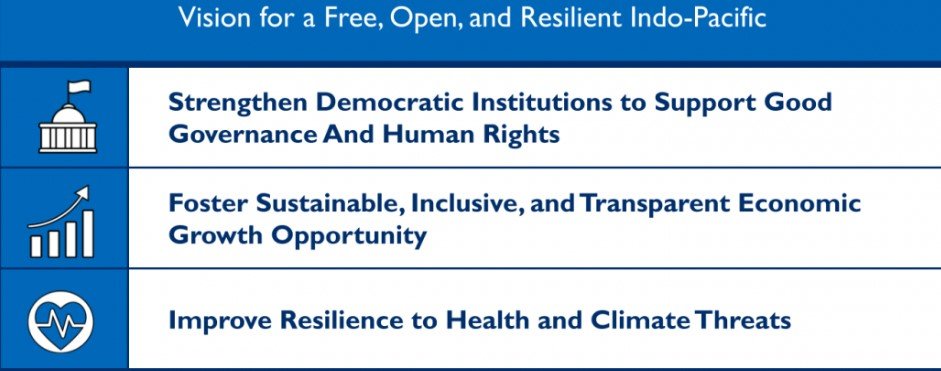
You Can Also Read: WHAT’S IN BANGLADESH’S 15-POINT INDO-PACIFIC OUTLOOK?
Defining the Region
The Indo-Pacific strategy envisions a free, open, connected, prosperous, resilient, and secure Indo-Pacific region in which all countries are empowered to adapt to the 21st century’s challenges and seize its many opportunities. A secure Indo-Pacific means that movements of people, ideas, and goods across the international sea, land, and air borders and across cyberspace are made legally. Maritime security has also gained a new dimension in recent time.
- Afghanistan/ Pakistan/ Central Asia: Afghanistan, Pakistan, Kazakhstan, Kyrgyzstan, Tajikistan, Turkmenistan and Uzbekistan.
- China
- East Asia: Japan. the Republic of Korea. Australia. New Zealand, Taiwan. Mongolia, Papua New Guinea, the Pacific Island nations. and North Korea.
- South and Southeast Asia: India. Bangladesh. Bhutan. Diego Garcia. Maldives. Nepal. Sri Lanka. Brunei, Burma. Cambodia, East Timor, Indonesia, Laos. Malaysia, Philippines, Singapore. Thailand. and Vietnam.
As the Atlantic, Pacific, and Indian Oceans were combined to form the Indo-Pacific, their significance increased. It was a noble concept. The integration of the entities captures the developing backdrop of international relations. That was primarily based on geopolitical and geostrategic concerns on the one hand, and since the world has become a multipolar environment, political predominance in the maritime domain has taken on a different shape.
China is a significant player in this scenario. Therefore, what China does and how it affects the status quo power is an almost unknown type of issue. However, the US-led western bloc was able to apply its knowledge and, as a result, rose to the thought forefront because of the experience of great power conflict from the 19th and 20th centuries under the bipolar framework. Consequently, within the broad umbrella of the Indo-Pacific region, a number of military alliances are emerging that ultimately serves to highlight the importance of the region.
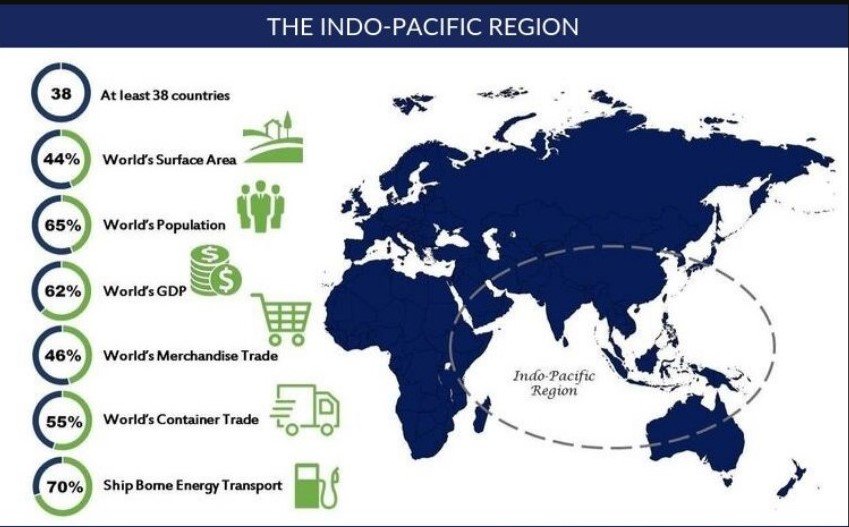
The size of the Indo-Pacific Region is also reflected in the US goal of rebalancing the Asian Pivot. Thus, the area evolved into a theater for international power politics. It is a type of departure from the traditional core of world politics that is Europe which grew dispersed. When one tries to predict who will control world politics in the future (after 20 or 30 years), it is astonishing to learn that it will be nations from the Indo-Pacific area. An unmatched arena of power politics is created by the cases of China, India, Japan, Australia, South Korea, and the ASEAN nations, with China and India receiving the majority of attention.
The Ukraine War has introduced some new security challenges, but the US and others also have their own baggage of issues. Here, Russia has turned into a constant foe of Europe. Russia, Europe, and the United States are mired in regional issues today, whereas they could hardly have imagined their global significance in the past. China and India have volunteered to take the lead in this situation. The west is worried that it will take them 25 years to reach a position of influence. They are attempting to soften reality by doing this. The more they can muddle the situation, the more they stand to gain from maintaining the status quo.
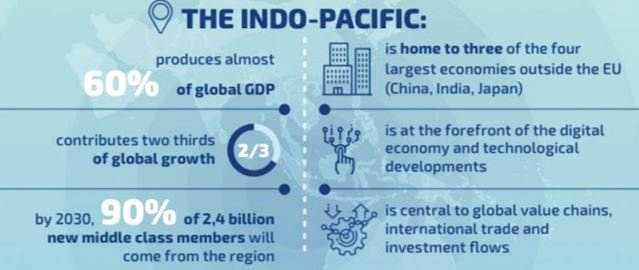
They would ensure their interest and dominance in world politics if they can contain China and India while maintaining a strong military and economic presence in the Indo-Pacific region. Because of this, the region is extremely important for the future global order as well as the US and the west.
Growing Geopolitical Strides
The Indo-Pacific region, which includes some of the most populated and economically vibrant nations in the world, is a big and crucial geopolitical territory. The region has become one of the key arenas for interstate conflict, competition, and collaboration in the 20th century. Some of the major players in the area, including the United States, Japan, Australia, and India, have coined the term “Indo-Pacific,” which is thought to combine “the Indian Ocean and the Pacific Ocean” or “these two oceans and the surrounding countries.” Although most nations refer to it as “an interconnected space between the Indian Ocean and the Pacific Ocean,” its exact geographical extent is not universally agreed upon. Bangladesh, a developing nation in South Asia, is a major participant in the area and would play a crucial role in its growing significance.
Moreover, from the east coast of Africa to the western coastlines of the United States- China, Japan, India, Australia, South Korea, ASEAN (Association of Southeast Asian Nations), and several island states in the Indo-Pacific rim are important political players in the region. Particularly in light of two significant developments, the region has grown significantly in political, strategic, and economic significance for the rising Asian order. One is China’s swift ascent throughout the Asia-Pacific and beyond, which has facilitated other powers to balance the region’s power dynamics. The irredentist claims made by China, particularly in the East and South China seas, open the door to territorial disputes with nations like Vietnam, the Philippines, and Japan.
The other is the US’s relative decrease in regional sway, which has made it necessary and advantageous for other significant countries like Japan, Australia, and India to play their own responsibilities in preserving political stability and fostering economic sustainability in the Indo-Pacific. However, the Indo-Pacific region has the potential to be a source of economic prosperity for the nations in the area because it serves as a hub for international trade and commerce. It is home to 46% of the world’s trade in goods, 65% of the world’s population, and 63 % of the global GDP. Additionally, the region controls 50% of global maritime trade. In addition, the Indo-Pacific is home to some of the most diversified global commons, which might lead to conflict in the region if strong powers compete for access to these resources.
The US is principally motivated by its ambition, which is set by the Biden Administration, to play a balancing role in the area and prevent China from consolidating its hegemonic dominance there. The increasing US-China trade conflict has only made matters worse, despite the fact that both nations have made an effort to start dialogue. While Japan shares the US’s objective of a “free and open Indo-Pacific,” it gives infrastructure development more of a priority outside of East Asia, such as in the Middle East and Africa. In order to strengthen its reaction to China’s strategic advances, the US has recently encouraged India to take on a bigger role in the area. However, under the SAGAR (Security and Growth for All in the Region) concept, India has cautiously argued for an inclusive vision for the area for all powers.
The sheer breadth and diversity of the Indo-Pacific area is one of the main factors contributing to its significance. The area spans a huge area of land and water, extending from the Pacific Ocean to the Indian Ocean and the South China Sea. Due to its diversity, the area has access to a variety of natural resources and economic and cultural opportunities.
Expanding Economic Horizon
The Indo-Pacific region’s expanding economic importance is another significant factor. Recent years have witnessed substantial economic expansion in nations like China and India, and the area as a whole has become a focus of international economic activity. For developing nations like Bangladesh, which take advantage of the enormous potential for commerce and investment in the region, this presents tremendous prospects.
Additionally, the Indo-Pacific area plays a significant role in geopolitics. Along with other smaller yet significant states, it is home to a number of strategic actors, including China, India, Japan, and the United States. As a result, it is an important space for political and strategic maneuvering and has a big impact on how the world approaches issues like trade, security, and human rights.
Moreover, the Indo-Pacific region provides developing nations like Bangladesh great possibilities for economic growth and development, as well as chances for collaboration and partnership with regional allies. Bangladesh may try to develop deeper economic relationships, improve its diplomatic position, and advance regional peace and security by engaging with the region and its major players. By doing this, it may establish itself as a major participant in the Indo-Pacific region and take advantage of all of its potential for its citizens. The region’s expanding economic significance offers a variety of trade and investment opportunities, particularly in the infrastructure, services, and manufacturing industries. For instance, Bangladesh has made significant investments in its infrastructure recently, creating new ports, motorways, and power plants to serve its expanding economy. As a result, the nation has drawn more and more foreign investors looking to take advantage of the region’s enormous potential.
Challenges in the Indo-Pacific Region
The Indo-Pacific region faces a number of complicated and interlinked issues that need coordinated responses from all stakeholders. These difficulties range from environmental degradation and marine security to economic inequality and cybersecurity. These problems can especially be severe for developing nations like Bangladesh since they might not have the means or capacity to handle them successfully on their own.
Maritime security is one of the main issues the Indo-Pacific area is currently experiencing. A variety of security challenges, including piracy, smuggling, territorial conflicts, and military tensions, are present throughout the large and intricate waterways of the region. Being a maritime nation in the Bay of Bengal, Bangladesh has been closely collaborating with its regional allies to strengthen its marine security and capabilities in order to address these issues, notably by establishing joint patrols and creating innovative technologies and approaches.
The importance of the Indo-Pacific region for international trade and security has only grown in recent years. It is crucial for nations looking to ensure their economic growth and stability because it is home to some of the fastest-growing economies in the world and a key trading route. Additionally, the area is crucial from a strategic standpoint because it is home to key chokepoints like the South China Sea and the Malacca Strait. The main powers of the globe depend on these chokepoints because they are essential to the movement of energy and trade around the planet.
As a result, the Indo-Pacific region is a battleground for influence and dominance among all major international powers, including the United States, China, Japan, India, and Australia. The battle between major nations has a big impact on both the global power balance and the security and stability of the region. The Indo-Pacific is a crucial region for all international powers to control because to its significance as a trading hub, strategic weak spots, and home to developing countries. It will certainly continue to be a key topic of international relations and foreign policy in the years to come since its importance is only expected to increase. Whatever the importance of the Indo-Pacific region, there should be continuing attempt to turn the region into a zone of peace and friendship instead of geopolitical rivalries that Father of the Nation of Bangladesh, Bangabandhu Sheikh Mujibur Rahman dreamt more than fifty years back.

